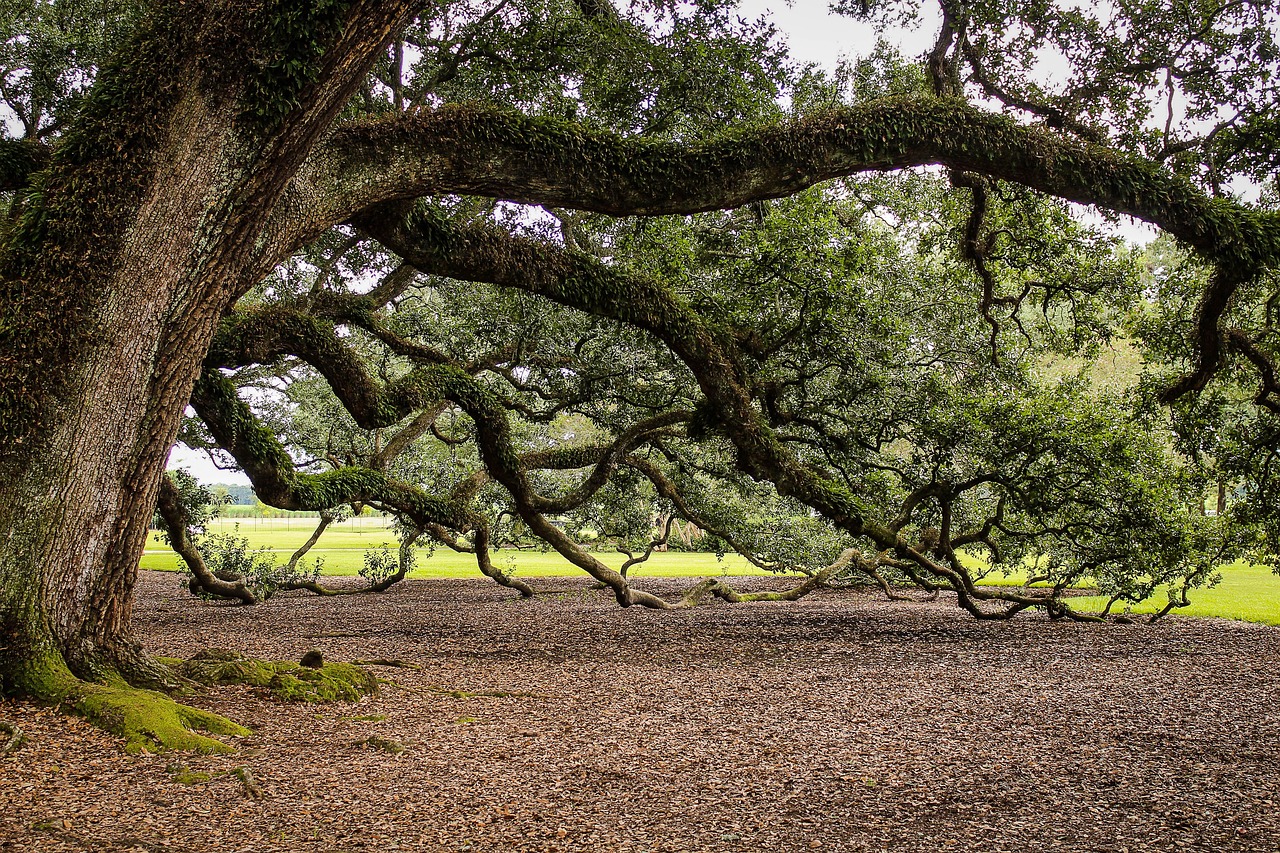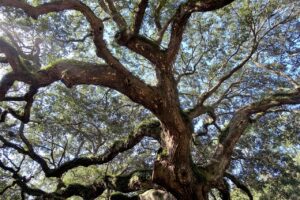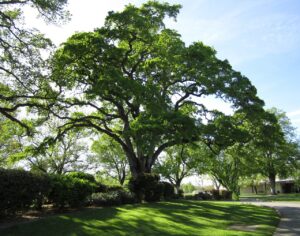Live Oak
Overview
The Live Oak, or Quercus virginiana, stands as a leafy emblem of strength and longevity. Majestic in form, this evergreen tree boasts wide-reaching branches and robust wood. It’s highly adaptable, flourishing in varied soils and braving salty breezes with ease. This venerable oak lends its grandeur to landscapes, providing deep shade and a touch of Southern charm, while its adaption to heat and humidity cements its place in the heart of warmer climes.

Characteristics
Known for its longevity, sturdy form, evergreen nature, broad spreading canopy, and resilience to various growing conditions.
Region
Native to the deep south of the United States, Live Oak thrives in heat and humidity.
Natural Habitat
The Live Oak is usually found in forests and coastal plains.
Cultivation
Thrives in full sun, tolerates various soils, and requires moderate watering, with adaptability to both wet and well-drained conditions.
Uses and Benefits
Live Oak trees, with their broad and twisting boughs, bring more than just aesthetic appeal to a landscape. They offer generous shade, creating cool, leafy retreats during hot summers2. This natural canopy is perfect for:
- Creating outdoor living spaces
- Providing solace to understory plants that thrive in dappled sunlight
Beyond their cooling effects, Live Oaks are culturally significant too; their stature as the state tree of Georgia speaks to their valued place in the region’s heritage2. These majestic trees are cherished for their ability to marry form with function, offering both:
- A striking visual presence
- Practical benefits, such as:
- Shade
- Habitat for wildlife
- Erosion control
Whether gracing a sprawling estate or standing sentinel in public spaces, Live Oaks are versatile trees that provide numerous benefits. Their expansive canopy and sturdy branches make them ideal for:
- Climbing and tree houses
- Hanging swings and hammocks
- Supporting wildlife like birds and squirrels
In addition to their practical uses, Live Oaks hold cultural and historical significance. They have been featured in literature and art, and have even played a role in military history, such as the “Old Ironsides” oak used to build the USS Constitution2.

Cultivation Tips
To cultivate a thriving Live Oak tree (Quercus virginiana), start by considering its natural habitat. These majestic trees flourish in warm, humid climates and can tolerate a variety of soil types, including acidic loam, sandy, and clay soils1. When selecting a planting location, ensure there is ample space for the tree to spread its branches and grow to its full potential, as Live Oaks can become quite large over time3.
To help your young Live Oak establish a strong root system, provide regular watering during the early stages of growth. As the tree matures, it becomes more drought-tolerant and can handle varying pH levels1. Live Oaks are also remarkably adaptable to coastal environments, tolerating salt spray with ease1.
For optimal growth, consider the following cultivation tips:
- Plant in an area with full sun to partial shade
- Ensure proper drainage to prevent waterlogging
- Mulch around the base of the tree to retain moisture and regulate soil temperature
- Prune regularly to maintain desired shape and remove dead or damaged branches
By mimicking the Live Oak’s natural growing conditions and providing proper care, you can cultivate a stunning, long-lived tree that will provide a cooling canopy of green for generations to come.
Seasonal Considerations
When it comes to seasonal considerations for growing a Live Oak tree, it’s essential to keep in mind that these majestic beauties thrive in warm, humid climates. To ensure your Live Oak flourishes, plant it in a spot that receives full sun to partial shade, providing ample room for its wide-spreading branches to grow unhindered.
Though Live Oaks are adaptable to various soil types, they prefer well-draining, acidic loam soil. Planting is best done in fall or winter, allowing the tree to establish its roots before the heat of summer arrives. While young Live Oaks benefit from regular watering, mature trees are incredibly drought-tolerant, making them a low-maintenance addition to your landscape1.
To keep your Live Oak healthy throughout the seasons, follow these tips:
- Mulch around the base of the tree to retain moisture and regulate soil temperature
- Prune only during the dormant season (winter) to avoid stress on the tree
- Fertilize in spring with a slow-release, balanced fertilizer for optimal growth
- Monitor for pests and diseases, addressing any issues promptly
With proper care and attention to seasonal needs, your Live Oak will reward you with its stately presence, providing shade and beauty for generations to come.

Issues and Troubleshooting
While Live Oak trees are generally robust and adaptable, they can sometimes encounter issues. One serious problem is oak wilt, a fungal disease that impedes the tree’s ability to transport water1. This disease can be devastating if not caught and treated early. To prevent oak wilt, regularly inspect your Live Oak for signs of disease, such as browning leaves or branches dying back.
Another potential issue is root rot, which can occur when Live Oaks are planted in poorly drained soils. Symptoms of root rot include:
- Yellowing or wilting leaves
- Stunted growth
- Fungal growth on the roots or at the base of the trunk
To prevent root rot, ensure your Live Oak is planted in an area with proper drainage. If you notice signs of root rot, you may need to:
- Improve soil drainage by adding organic matter or installing drainage systems
- Reduce watering frequency
- Apply fungicides to treat the infection
Pests like caterpillars and borers might also visit your Live Oak, but the tree can generally withstand these invasions without much harm. However, it’s still important to regularly inspect your tree for signs of infestation, such as:
- Holes in the bark
- Sawdust-like material around the base of the tree
- Chewed or skeletonized leaves
If you notice any signs of pests, promptly treat the infestation with appropriate insecticides or natural remedies. By staying vigilant and addressing issues quickly, you can help maintain the health and beauty of your Live Oak tree for years to come.
History and Folklore
Live Oak trees, known botanically as Quercus virginiana, possess a rich tapestry of history and folklore that’s as sprawling as their mighty branches. These majestic trees symbolize strength and endurance, with some specimens surpassing 200 years of age. In American folklore, Live Oaks are deeply connected to spirits and timeless stories.
Two of the most venerated Live Oaks in South Carolina, the Middle Oak and Angel Oak, are shrouded in tales of their own. The Angel Oak is believed to be between 400 to 500 years old5, standing as an ancient sentinel that has silently witnessed centuries of history. The cultural significance of Live Oaks is further emphasized by the designation of this species as the state tree of Georgia2.
Often central to local lore, these awe-inspiring trees are interwoven with the stories of the regions they have stood watch over for generations. As living landmarks, Live Oaks continue to capture the imagination and hearts of those who encounter them, serving as enduring symbols of the past and the unwavering spirit of the communities they grace.
References
1. Live Oak Tree Care: Learn How To Grow A Live Oak Tree, https://www.gardeningknowhow.com/ornamental/trees/oak/live-oak-tree-care.htm
2. Live Oak – Description, Planting and Growing, https://www.treehugger.com/manage-and-plant-live-oak-plant-1343357
3. Live Oak Tree: Leaves, Bark, Acorns (Pictures), https://leafyplace.com/live-oak-tree/
4. Live Oak: Care and Growing Guide, https://www.thespruce.com/live-oak-growing-guide-5199363
5. Live Oak (Quercus virginiana): Southern Majesty and Resilience, https://www.gardenia.net/plant/quercus-virginiana
Image Credit: JamesDeMers
Image Credit: GeorgeB2
Image Credit: iris4me
Nicolas Duval
Nicolas is a passionate advocate for nature and the art of wildcrafting. His dedication shines through in Wildcraftia, a website he meticulously crafted to serve as a haven for nature enthusiasts worldwide. Driven by a deep appreciation for nature’s connection to humanity, Nicolas embarked on his journey in 2011 with SmokableHerbs, a platform showcasing his love for nature’s bounty. Building upon this foundation, he established Smokably, a thriving online store offering premium herbs and blends to a global audience.
